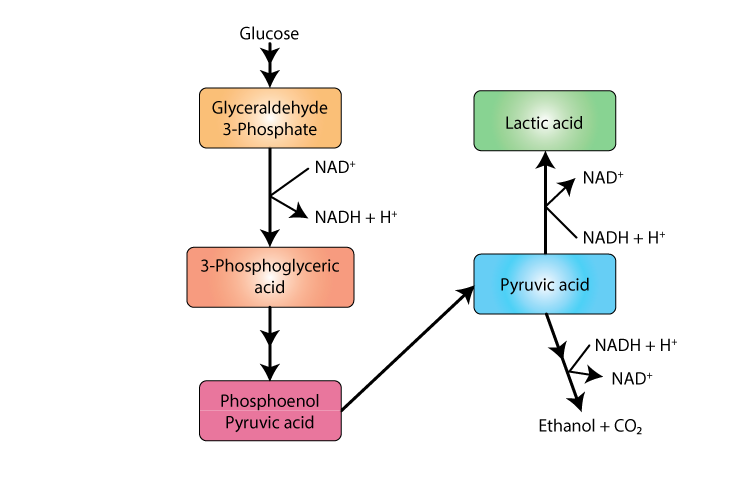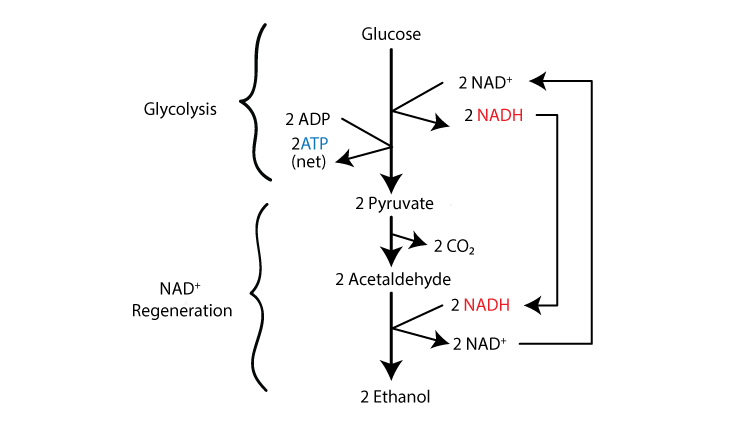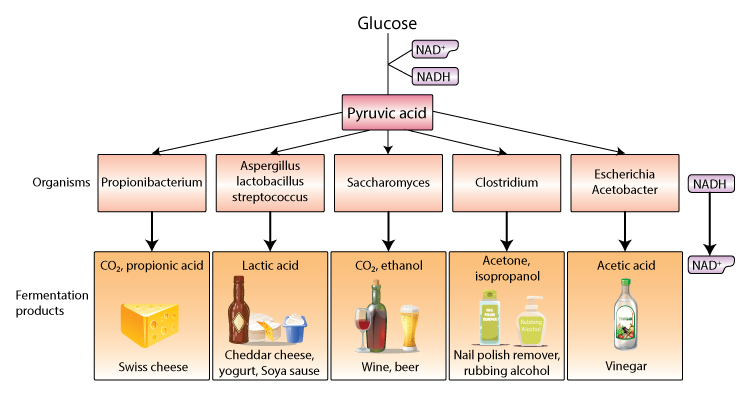Table of Content
Download Complete Chapter Notes of MIcrobes in Human Helath
Download Now
All living organisms get the energy required to perform cellular functions by respiration. In most of the animals, respiration occurs in the presence of oxygen (aerobically). Some organisms like bacteria, yeast, etc. can produce energy in the absence of oxygen (anaerobically).
| Download: NEET 2022 Answer Key With Solutions |
Fermentation – Definition
Fermentation is an enzyme catalysed, metabolic process whereby organisms convert starch or sugar to alcohol or an acid anaerobically releasing energy. The science of fermentation is called “zymology”.

Process of Fermentation
Fermentation is an anaerobic biochemical process. In fermentation, the first process is the same as cellular respiration, which is the formation of pyruvic acid by glycolysis where net 2 ATP molecules are synthesised. In the next step, pyruvate is reduced to lactic acid, ethanol or other products. Here NAD+ is formed which is re-utilized back in the glycolysis process.

Also Check: MCQs on Fermentation Process
Types of Fermentation
- Homo fermentation: only one type of product formation
- Hetero fermentation: more than one product formed
On the basis of the end product formed, fermentation can be categorized as follows:
1. Lactic Acid Fermentation
Lactic acid is formed from pyruvate produced in glycolysis. NAD+ is generated from NADH. Enzyme lactate dehydrogenase catalyses this reaction. Lactobacillus bacteria prepare curd from milk via this type of fermentation. During intense exercise when oxygen supply is inadequate, muscles derive energy by producing lactic acid, which gets accumulated in the cells causing fatigue.
![]()

2. Alcohol Fermentation
This is used in the industrial production of wine, beer, biofuel, etc. The end product is alcohol and CO2. Pyruvic acid breaks down into acetaldehyde and CO2 is released. In the next step, ethanol is formed from acetaldehyde. NAD+ is also formed from NADH, utilized in glycolysis. Yeast and some bacteria carry out this type of fermentation. Enzyme pyruvic acid decarboxylase and alcohol dehydrogenase catalyse these reactions.
![]()

3. Acetic acid Fermentation
Vinegar is produced by this process. This is a two-step process.
The first step is the formation of ethyl alcohol from sugar anaerobically using yeast.
In the second step, ethyl alcohol is further oxidized to form acetic acid using acetobacter bacteria. Microbial oxidation of alcohol to acid is an aerobic process.
![]()
4. Butyric acid Fermentation
This type of fermentation is characteristic of obligate anaerobic bacteria of genus clostridium. This occurs in retting of jute fibre, rancid butter, tobacco processing and tanning of leather. Butyric acid is produced in the human colon as a product of dietary fibre fermentation. It is an important source of energy for colorectal epithelium. Sugar is first oxidized to pyruvate by the process of glycolysis and then pyruvate is further oxidized to form acetyl-CoA by the oxidoreductase enzyme system with the production of H2 and CO2. Acetyl-CoA is further reduced to form butyric acid. This type of fermentation leads to a relatively higher yield of energy. 3 molecules of ATP are formed.
![]()
Advantages of Fermentation:

Fermentation is suitable for all kinds of environments. It is one of the oldest metabolic processes which is common to prokaryotes and eukaryotes. Fermentation is widely used in various industries.
Using suitable microorganisms and specified conditions different kinds of fermentation products are formed namely:-
- Wine
- Beer
- Biofuels
- Yoghurt
- Pickles
- Bread
- Sour foods containing lactic acid
- Certain antibiotics and vitamins
Fermentation can make food nutritious, digestible and flavoured. There are many benefits of consuming fermented food.
- It improves digestion and helps to maintain intestinal bacteria
- It has an anti-cancer effect.
- Improves immune system
- Reduces lactose intolerance
Other than the food industry, there are many other areas where the fermentation process is used. Methane is produced by fermentation in sewage treatment plants and freshwater sediments.
Also read:
Recommended Video:
Respiration in Plants Class 11 Biology (Mitochondrion, Glycolysis and Fermentation) | NEET 2022

Frequently Asked Questions
What is the definition of fermentation?
Fermentation is a metabolic process that releases energy from sugar or other organic substrates through various enzyme actions. It is a type of anaerobic biochemical process.
What is industrial fermentation?
Here, microorganisms such as fungi and bacteria are intentionally used for fermentation to make end products that are beneficial to humans. Common commodity chemicals such as citric acid, acetic acid and ethanol are made by industrial fermentation.
What are the four types of fermentation?
Based on the end product formed, fermentation can be classified into four types namely, lactic acid fermentation, alcohol fermentation, acetic acid fermentation, and butyric acid fermentation.
Also Read:
- What is Electrocardiogram?
- What Is Dwarfism?
- What is Bioprocessing?
- What are the Symptoms of Thyroid?

Comments